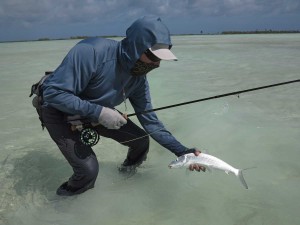Christmas Island Fly Fishing Gear
Any of you who follow our RiverFly Tasmania blog would know that I’ve recently returned from a great trip to Christmas Island, chasing bonefish. But finding information on what gear what to take on our recent trip was really hard. So with the benefit of experience, we’ve created a post on what gear we recommend, and why.
Rods and reels for bonefish
Out of nine or so of us on the trip, all of us had six-weights as our primary rods. For all-day fishing, this was an ideal rod weight. Seven and eight-weights were better at casting into the wind, but they were more tiring to use for a full day of fishing. An important thing to note with the rods, is to make sure you have the saltwater fittings – a double up-locking reel seat is important to stop the reel coming undone on powerful fish, and a small fighting-butt is essential. My rod of choice was the Orvis Helios six weight, with saltwater fittings, and was one of four Helios 2 rods used in our group.
Fly reels were very, very important. You can’t shortcut this part of the rig, as it does all the work in playing fast and powerful fish such as bonefish, which have no trouble breaking 16lb tippets. When choosing your reel, four features are important:
1. The reel must be fully-machined. A cheaper die-cast reel will spin itself off the spindle, or warp a spool within the first day.
2. The reel should be comparatively light. A good quality, fully machined alloy reel will be a lightweight work of art. Avoid buying a heavy reel, regardless of quality, as it will quickly wear you out when casting all day.
3. The reel should have a medium to large arbor (diameter). A medium to large arbor reel will not turn as fast when fish are taking lots of line, which reduces friction, inertia, and improves drag-effectiveness. A larger arbor reel also retrieves line quicker, which is important when you have 200 yards out on each run.
4. The drag must be fully sealed. Drag designs come in many shapes and sizes, but it must be completely sealed. One piece of coral-sand in a drag system can be catastrophic.
My reel of choice was in fact my day-to-day trout reel, the Orvis Mirage III. The stacked-disc drag is completely impervious to water and sand, and survived a dozen or so dunkings underwater, and on the beaches. It also landed over 100 bonefish, and almost 20 trevallys and other species. Also on the trip with us was a Mirage IV, which is the next size up. If I spent more time in the saltwater, I would certainly get this size as my second reel, for all my 6-9 weight saltwater needs.
Lines and leaders
My personal flyline of choice for the trip was a Rio Bonefish line. It worked without fault, and was a perfect match for the fly range we were using. For leaders I used 10 foot, 20lb Rio Saltwater leaders, always with a tippet off the front which helped to control the heavier flies. The tippet was Orvis Mirage fluorocarbon, which performed the best out of the brands on the flats. A 2-3 foot tippet of 16lb was the most common, but for some really spooky tailing bones we used 12lb which converted a lot more follows into hookups, and conversely, we switched to 20lb on the sharp reefs.
Backing was Orvis gel-spun, which is one of the smallest diameter on the market (I fit 225 yards of 35lb on to my Mirage III reel), which in turn was joined to the flyline with a large braided loop. If you are heading to Christmas Island, we can create these custom joins for you, making line changes easier, and creating stronger connections.
Clothing and wading boots
I packed two different kits to cope with full-days of tropical sun. The first was the traditional style fishing shirt (in my case the Patagonia Sol Patrol shirt), and some lightweight shorts. The Sol Patrol was awesome for travelling in – quick to dry when washed, has a great little security pocket for cash and passports, and was comfy on the flats. Shorts were also great, but by the end of the first day, I was sick of slathering sun-cream on by the hour. This is when I switched to kit number two!
My second kit for the trip consisted of lightweight long pants (Patagonia tropic pants), and the brilliant Patagonia sun hoodies. Pants (compared with shorts) were brilliant. I didn’t have to worry about burning legs, and even better, the evaporative cooling effect of the wet trousers worked really well. The sun-hoodies were the real hero’s though. With these on, paired with a buff and cap as pictured, there was barely any need for sun-cream. No sun-cream running into your eyes, and no sun-cream smearing on your glasses. Having sleeves free of cuffs also help with line management.
In terms of wading boots, there are two options: dive booties, or more traditional wading boots. The beauty of the fly fishing at Christmas Island is that it is all wade fishing (as opposed to flats-boat fishing). There is plenty of hard and sharp coral, which is why I went with a standard wading boot, and never looked back. My boot of choice was the new Patagonia Ultralight Wading Boot, which has was brilliant and light to travel with, but very well built and designed. It kept the sand and coral out, and didn’t suffer from any of the ‘shredding’ that some of the dive-style booties suffer from.
Flats bags
We had various chest packs and bum bags on the trip, including Orvis Sling Packs, Patagonia Sling Packs, Recycled Waders Nook Sacks and Patagonia Stormfront Hip Packs. Out of the various options, my favourite was the Patagonia Stormfront Hip Pack (which I was using), and the Patagonia Sling Pack–the sling pack was actually used by one of the guides, Shimano, whom had it for more than a year of use, everyday on the flats. That’s a great testimonial to the quality of this gear.
As mentioned, I used the Stormfront Hip Pack, a completely waterproof (submersible) hip-pack from Patagonia. The small internal mesh pockets were ideal for spare leaders, 3 tippet spools (12lb, 16lb and 20lb), suncream, sunglass cleaner and lip-balm. The large main compartment was perfect for storing my 800ml Kleen Kanteen, Cliff’s Crab Shack fly box, and camera. The piece of mind of having a dry-suit zip was awesome, especially when wading among the tidal surges, chasing metre-long milkfish, and is certainly worth the money.
Flies
I got some great advice on flies from our mate Simon Taylor, who had been on two previous trips to Christmas Island. The selection was simple but deadly, with two different patterns (variations of the Christmas Island Special, and the Gotcha), in three different weights (beadchain, 5/32 dumbell, and 3/16 dumbell). The most important thing was to have enough of each size. On a couple of occasions I went through six or seven flies in an hour–this was common when we chased the biggest bones (6-10lbs), tailing on sections of reef during the end of the run-out tide. Based on this experience, I’d recommend 30 flies in each of the two lighter weights, and 15 of each patterns in the heavier weight. For a one week trip, this equates to 150 flies.

